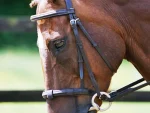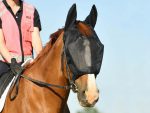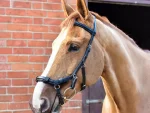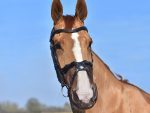1 year product guarantee
Free delivery on most orders over £40
Rated 4.9/5 stars on Feefo

Researched & tested products

Innovating for over 20 years!
Supporting Redwings Horse Sanctuary & Brooke
Feefo Gold Trusted Service Award Winner
Get more time to pay with Klarna
Headshaking - Common Myths Exposed
By Dr Katy Taylor,
De Montfort University
Head Shaking is not a single condition
One of the most frustrating things about headshaking is that each case is unique. So, what causes headshaking in one horse may not be the cause in another. It’s important to recognise that headshaking is the symptom of a problem with the horse rather than being the problem itself, although it is often treated as such.
There are over 60 known causes of headshaking, including ear, eye and respiratory problems, which makes a veterinary visit all the more important. Simply assuming your horse is an untreatable head shaker may cause more harm. Likewise, be wary of products that claim to cure all head shakers.
Headshaking is not a behavioural or management problem
Because headshaking often only arises when the horse is ridden, it is commonly attributed to tack problems, bad riding, or resistance. However, studies in the US and UK have shown that around 50% of head shakers also show symptoms at rest. So, whilst exercise always worsens the symptoms, most owners find that changes in tack or schooling have little effect.
Researchers at De Montfort University and the University of Lincoln investigated head shakers and non‑head shakers and found no important differences in their diet, use or turnout. The relative unpredictability of the condition and symptoms suggest that the headshaking is not a behavioural one unlike weaving or nodding.
Not all headshaking is caused by sunlight (photic headshaking)
Head shaking has often been attributed to a reaction to sunlight, but whilst this may be so for some, especially animals in more sunny places like California, many European head shakers seem relatively unaffected by light. Riding indoors or at dusk can still bestow benefits other than by restricting exposure to light so the best test for the photic form of this problem is to carefully cover the horse’s face whilst exercising.
Headshaking is not horse hay fever
The seasonal nature of headshaking (50% of head shakers only have symptoms from March to October), together with the signs of nasal irritation, has led many to believe that headshaking is a respiratory disorder similar to human hay fever. However, vets remain sceptical because, in general, hay fever medication is not very effective. In addition, vets rarely find clinical signs of an allergic reaction. Although headshaking may be in response to particles in and around the nose, an allergic reaction may not necessarily be occurring.
So what does cause headshaking?
Given there are a variety of causes, a large proportion of head shakers are thought to be suffering from some kind of pain originating within the head. Nerve pain (neuralgia) has long been considered, ie. damage to the sensory nerves of the head, which may have resulted from physical damage to the nerves or following infection from certain viruses.
The involuntary headshaking movement could be a response to the misfiring of a faulty nerve and the rubbing of the face in an attempt to relieve the discomfort caused. Facial neuralgia could account for the general hypersensitivity around the muzzle that many head shakers experience, particularly to rain, snow and wind. In some cases, exercise or particles may be causing the blood vessels in the nose to swell and ‘squash’ the nerve, causing it to misfire.
The reasons why some horses head shake and others don’t are not yet known. Frequently the onset of their problem has been traced back to the beginning of the horse’s working life so the many changes that occur within the horse or in its environment during this time may hold part of the answer. Because the problem is often not apparent until the horse is exercised, headshaking could have arisen earlier when the horse was very young but has lain undetected until the horse was backed.
Future research into how we can prevent headshaking in foals may be fortuitous once we know more about the causes of headshaking.
Category
Equine Ailments, Headshaking, WellbeingRelated Articles
View all articlesHead shaking – here’s a little hope!
Read articleRelated Products
View all products-
 Net Relief Muzzle Net£24.99 View product
Net Relief Muzzle Net£24.99 View productNet Relief Muzzle Net
Reduce headshaking* with the Net Relief Nose Net for horses…
-
 Net Relief Riding Mask£24.99 View product
Net Relief Riding Mask£24.99 View productNet Relief Riding Mask
Stress-free summer hacking with this ride on fly mask which…
-
 Net Relief Muzzle Net for Anatomical Bridles£29.99 View product
Net Relief Muzzle Net for Anatomical Bridles£29.99 View productNet Relief Muzzle Net for Anatomical Bridles
Reduce headshaking* with this Net Relief Nose Net for Anatomical…
-
 Net Relief Muzzle Net for Grackle£29.99 View product
Net Relief Muzzle Net for Grackle£29.99 View productNet Relief Muzzle Net for Grackle
Reduce the shaking* with this Net Relief Nose Net for…
